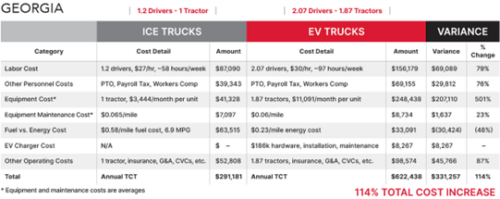Following government initiatives promoting the full-scale adoption of electric trucks, a recent report released by Ryder highlights the substantial costs associated with transitioning fleets to electric vehicles, a move that could significantly contribute to overall inflation.

Ryder’s comparative analysis reveals that switching to electric would double the operational costs of its Class 8 vehicles.
Drawing from extensive data, Ryder’s assessment of Class 8 vehicles involves diesel trucks with a haul range of 100 to 500 miles, making one to two trips per day, covering an annual distance of 109,000 miles, and manned by two drivers, carrying an average payload of 29,000 pounds.
However, with current technological constraints, electric trucks can only manage a maximum payload of 22,000 pounds. This limitation, combined with longer charging and delivery times, calls for nearly doubling the number of electric trucks and drivers to match the output of a single diesel truck.
The financial implications are significant. Replacing just one diesel truck amounts to hundreds of thousands of dollars annually, mainly attributed to the high cost of electric trucks themselves. Ryder’s calculations indicate a fivefold increase in monthly payments for electric trucks, exceeding $200,000 per year.
Additionally, substantial increases are predicted in labor costs (76%), other personnel expenses (74%), and operating costs (87%). These expenses cover various aspects such as compensation, paid time off, payroll taxes, insurance, administrative expenses, and the installation of chargers—an additional $8,000 per year per fleet.
Comparing operating costs between California and Georgia, Ryder notes that while truck operations are higher in California, the percentage increase resulting from transitioning to electric trucks is more pronounced in Georgia due to fuel prices. In California, the fuel cost savings for electric trucks are more substantial compared to Georgia, where diesel remains significantly cheaper.
The impact of electric truck conversion also varies across different truck classes. For Class 4 and 6 trucks, the savings in maintenance and energy costs partially offset the increases in labor and equipment expenses. This results in a 5% cost increase in Georgia. Medium-haul straight trucks, on the other hand, are projected to face a yearly cost increase of approximately $50,000, causing a 25% rise. For a mixed fleet of 25 vehicles of vans, straight trucks, and tractors, the annual cost increase is estimated at 56% in California and 67% in Georgia.
With operational costs for tractor-trailers more than doubling in certain regions and mixed fleets experiencing significant increases, the transition to electric trucks poses a considerable challenge. Such cost increases would, without doubt, be passed down to consumers, potentially adding up to 1% to overall inflation, according to Ryder’s estimates.
Ryder’s analysis assumes easy and convenient access to fast-charging infrastructure, which is currently underdeveloped. The lack of sufficient charging stations is a critical bottleneck, with only a limited number of ports available nationwide. Meeting the demand for charging infrastructure will require substantial investment and time, with estimates suggesting the need for nearly 600,000 chargers by 2030.
Ryder’s report happened at the same time as recent federal initiatives to strengthen emission standards for trucks and passenger vehicles, including mandates for zero-emission vehicles. However, there’s also opposition to these regulations, highlighted by a Congressional Review Act resolution aiming to repeal the new truck emission rule introduced by Republicans.
Stakeholders in this issue, including professional drivers, are urged to contact their policymakers. Organizations like the Owner-Operator Independent Drivers Association advocate against the new regulations and encourage support for better resolutions.
“Small-business truckers make up 96% of trucking and could be regulated out of existence if the EPA’s misguided mandate comes into effect,” said Todd Spencer, OOIDA president. “This could have devastating effects on the reliability of America’s supply chain and ultimately on the cost and availability of consumer goods. Local mom-and-pop trucking businesses would be suffocated by the sheer cost and operational challenges of effectively mandating EV trucks.”
Source: Land Line











